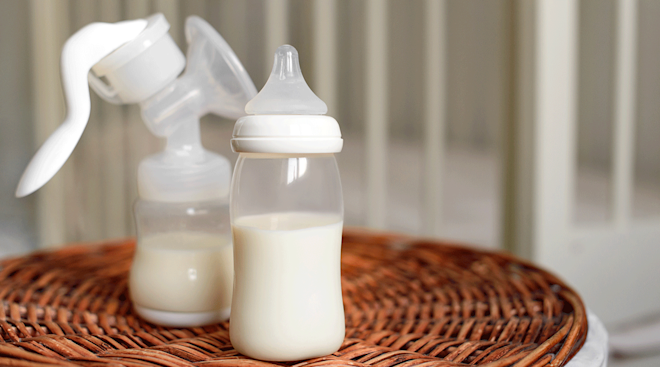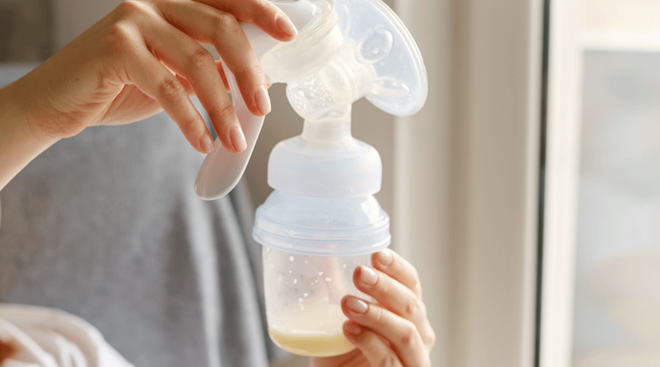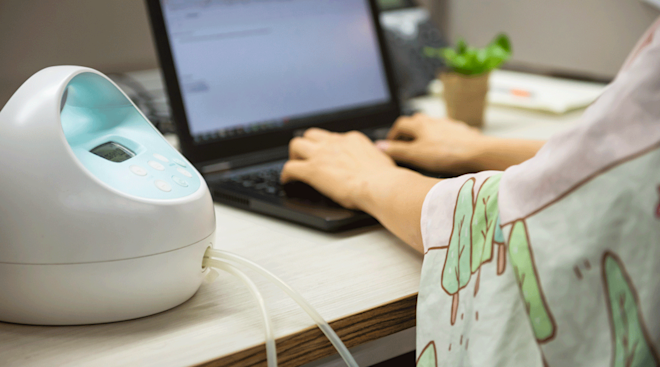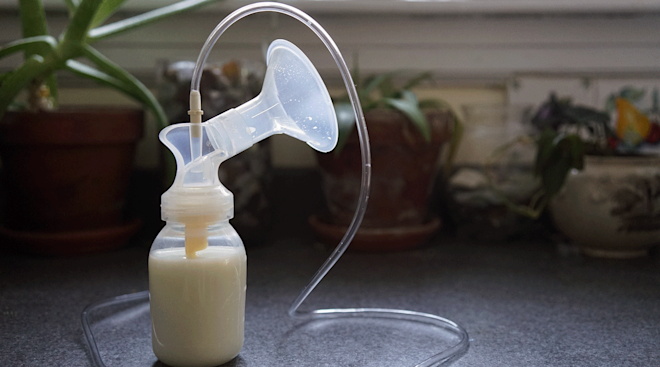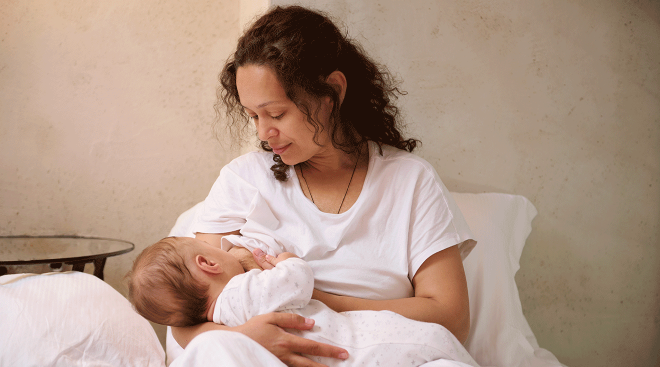30 Breastfeeding Tips Every Nursing Mom Should Know
Breastfeeding is a beautiful and natural journey—but what may be natural isn’t always intuitive (at least at first), for either Mom or baby. There are several different aspects of breastfeeding that play a big role in success, including baby’s latch, milk supply, your natural breast shape and so much more. While challenges may arise as you and baby get the hang of breastfeeding, don’t stress. Here, experts and experienced moms offer their best breastfeeding tips to set you and baby up for success.
Once baby arrives, moms are typically encouraged to start breastfeeding right away. But how will you and baby know what to do? Will they instinctively understand how to latch on? And when will mature breast milk come in? Below, the important breastfeeding tips for new moms to keep in mind.
Breastfeed right after birth
Breastfeeding within the first hour of birth, or as soon as possible, is key to setting you and baby up for future success, says Susan D. Crowe, MD, an ob-gyn and clinical associate professor at Stanford University School of Medicine. In fact, allowing new moms and babies to have skin-to-skin contact right after delivery encourages newborns to start breastfeeding in the first 30 to 60 minutes. “That early initiation for breastfeeding is extremely important when it comes to sending signals to the brain and body to produce breast milk,” Crowe adds. Even if baby needs immediate medical attention or requires a stay in the NICU, you can still start hand expressing breast milk to stimulate those breastfeeding signals in your body.
Know your breast milk will change
Even before baby’s arrival, it’s better to do your research beforehand to get an idea of exactly what to expect during each stage of breastfeeding. At the start, your body produces only a small amount of yellowish breast milk called colostrum. Baby will only drink a few drops, but that’s really all they initially need. Eventually, transitional milk will come in as baby feeds, followed by mature breast milk.
Get comfortable positioning baby
Handling a tiny new baby can be scary, but it’s important to get comfortable holding them. Don’t be afraid to take control and bring baby to the breast, says Tamara Hawkins, an IBCLC-certified lactation consultant and the director of Stork and Cradle, Inc. “The No. 1 reason moms have pain is because they’re being too gentle,” she adds. Trust yourself and know the best breastfeeding position is the one that’s going to be most comfortable for both you and baby.
Ask a lactation consultant
If you delivered at a hospital, lactation consultants are usually available onsite to help new moms breastfeed baby right after birth. But they can also help provide breastfeeding education during pregnancy, as well as breastfeeding support for problems that arise during the fourth trimester. While you can always find a lactation consultant after baby’s arrival, having one beforehand can help ease some stress. Ask a loved one with nursing experience for recommendations, your ob-gyn for a referral or look through the International Lactation Consultant Association website.
Let others help with housework
Perhaps the biggest breastfeeding tip for new moms? For the first six weeks, while you’re establishing your breastfeeding, let others help out with chores around the house. “That means you shouldn’t be cooking, cleaning, doing the dishes or changing the diapers,” Crowe says. “To fully support mom’s [breastfeeding] efforts, let others do everything else—because nursing baby is the one thing they can’t do.” And when you’re not actively breastfeeding, focus on self-care, including eating well and getting rest. “If you invest the time initially, it’ll pay off in huge dividends later,” Crowe says.
Establishing a good latch early on is one of the most important tips for successful breastfeeding. In fact, an improper latch can not only cause pain, but it can actually damage the nipples. It’s important to correct baby’s latch early on, Crowe says. Sometimes it’s a simple fix, like pulling baby’s chin down to make sure their lips are flanged outward. Other times it’s an issue of baby’s anatomy or your breast anatomy, and finding a remedy may call for professional help. Below, some breastfeeding tips to help baby latch on to the breast correctly.
Know what a proper latch is
Learning how to position your newborn and ensuring they have a good latch can take time, but it’s important to know what you’re looking for. “You want to make sure baby is latched tightly to the breast so their cheeks and chin appear seamlessly attached to you,” Hawkins says. “You shouldn’t be able to see their lips, and it should feel comfortable.” Baby should also latch to the entire breast, rather than just the nipple. The bottom of your areola (the area around the nipple) should be in baby’s mouth and the nipple should be toward the back of their mouth, where the palate is soft and flexible. This wider latch allows for baby to effectively empty the milk ducts around the nipple, Crowe explains. If baby’s latched only to the nipple, not only will it cause you pain but it won’t fully empty your breast. This means baby isn’t getting a good feed and your body isn’t sending signals to the breast to make more milk (which could impact supply).
Tease baby’s mouth open
If you have larger nipples, it may be difficult for baby to get a good latch early on. If the nipple fills most of baby’s mouth, they’ll struggle to get enough of the areola to compress the milk ducts and drink enough milk. One breastfeeding tip that can help is teasing baby’s mouth open by pushing the nipples against their upper lip. This encourages them to lift their head up and back and open wide, helping them to latch onto some of the areola as well as the nipple.
Use a breast pump
Another tip for breastfeeding with larger or inverted nipples is to use a breast pump during those first few weeks. Pumping can help draw out the nipple, making it better positioned for baby to latch onto, Crowe says. It’s also a good way to help maintain your milk supply until baby has an easier time latching and feeding.
Consider using nipple shields
If you have flat or inverted nipples, a nipple shield may help improve baby’s latch: Placed over your actual nipple during nursing, an artificial latex or silicone nipple shield has little holes in the tip to encourage milk flow and stimulate the roof of baby’s mouth to trigger a sucking reflex. But it’s best to use a nipple shield under the guidance of a lactation consultant, who can make sure it’s done properly without interfering with baby’s feeding or causing damage to Mom’s nipples.
Put pressure on your areola
If you have swollen breasts—to the point where the nipples appear flat and drawn in—and baby’s struggling to latch, try placing your hand around the areola and pushing your breast into your chest, Hawkins suggests. The manual pressure can reduce a lot of the swelling and help the nipple pop out. You can also try manually pulling out or rolling the nipple between your fingers, or even using suction devices to help correct inverted nipples, she adds.
Check for lip- or tongue-tie
If baby is struggling to nurse and get enough milk, it could be a lip- or a tongue-tie. Brush up on the symptoms for both and don’t hesitate to contact your pediatrician or lactation consultant with questions. C. Robinson, mom of a 21-month-old, had a very painful breastfeeding experience until she met with a lactation consultant who discovered her daughter had both a lip- and tongue-tie. Her daughter underwent surgery at 4 months to correct the problem, and “it made the world of difference for both of us,” Robinson says.
One of the biggest breastfeeding concerns new moms have is increasing and maintaining a strong milk supply to ensure baby gets a good feed. The good news? Breastfeeding is biologically instinctual—studies show the more milk baby (or a pump) expels from your body, the more milk it will produce. But this can often be trickier than it sounds, and milk supply may dip for many reasons. Check out the below breastfeeding tips for how to prevent supply from dipping and how to check if baby’s getting enough milk.
Don’t skip sessions if baby bottle feeds
If you’ve introduced a bottle to baby after a few weeks, you’ll still need to pump while baby bottle-feeds. This way your body knows to keep up with milk production. If you decrease the number of breastfeeds or pumping sessions, your supply will likely begin to dip.
Try eating galactagogues
Certain foods, known as galactagogues, have been said to naturally increase breast milk supply, including oatmeal, barley, flax seed and some herbs, like fenugreek and alfalfa. Plus, there are tons of pre-made lactation teas, cookies and supplements that utilize these ingredients and can help boost supply.
Monitor baby’s birth weight
One breastfeeding tip to assess if baby’s getting enough milk is to keep an eye on their weight. “One of the earliest markers /[that baby’s not getting enough to eat] is if they’ve lost more than 10 percent of his birth weight by the first pediatrician visit, which usually happens three or four days /[after being discharged from the hospital],” Hawkins says. Another clue something’s off: When you don’t feel your breasts become engorged with milk by day five. If you don’t feel an obvious fullness by then, check in with a lactation consultant. Even after those initial weeks, as long as baby is gaining weight and is happy and healthy, odds are they’re feeding just fine.
Count dirty diapers
The number of wet and dirty diapers baby produces can also be a sign they’re getting enough milk. “If Mom is five days postpartum and has a full milk supply, she should be seeing a minimum of four to five urine- and stool-covered diapers a day,” Hawkins says. You can also bet baby is getting breast milk if your breasts become softer after nursing, you hear little swallowing sounds and baby looks satisfied.
Once you and baby start venturing out of the house, chances are they’re going to get hungry. Breastfeeding in public can be nerve-racking for some, but know that it’s your right to feed baby whenever, wherever you need to. Check out these tips for breastfeeding in public to help you prepare with confidence.
Wear convenient clothing
Luckily, there are tons of nursing bras, tank tops and other clothes on the market that make breastfeeding in public a breeze. But if you don’t want to invest in nursing-specific gear, Hawkins suggests layering shirts, like wearing a tank top underneath a T-shirt. This way, “the T-shirt is still covering the top part of your body, the tank top is covering your belly and baby is covering your breast,” she says.
Practice in private
If you’re nervous about breastfeeding in public, try practicing at home beforehand. Figure out how to hold baby without a pillow and how to dress for easy access. “Practice pulling your shirt and bra down and giving baby access to the breast at home in front of a mirror to gain a bit more confidence,” Hawkins says.
Find a quiet corner
Find a quiet spot if you can so baby isn’t overstimulated by what’s happening around you. “I would just find a seat away from everyone else,” says Stacey, a Bump user and mom who nursed her son. “This was more to prevent my son from being distracted than for privacy.”
Don’t feel pressured to use a cover-up
Nursing covers may work if baby is small, but if it’s warm out it can get pretty hot under there and baby will start to sweat, Hawkins warns. “I never used a cover because my son would have ripped it off and brought more attention to us than just nursing like normal,” Stacey says. There’s no need to use a cover-up if you don’t want to. After all, it’s your right to feed your child whenever, wherever and however you wish.
Pack the essential accessories
One of the most important tips for breastfeeding is to have all the essentials ready to go in your bag. If you’re traveling and need to pump, make sure you have a hand pump in addition to your normal electric one in case there aren’t outlets or your battery dies. “I got comfortable with pumping in public when I was in the airport,” says Laurie Davis Edwards, mom to daughter Ellie. While many airports have made strides towards having mothers’ and lactation rooms, not all airports have them. “I put a cover over me and pumped at the restaurant while eating before my flight,” she adds.
Going back to work signals a change in your breastfeeding routine. After all, you won’t be around to feed baby whenever they’re hungry. Many first-time moms worry about keeping up their nursing—and their milk supply—once they return to the office, but there are plenty of breastfeeding tips to help you navigate the transition.
Practice pumping before heading back to work
Before going back to work, practice pumping once a day or every other day, Crowe says, since getting a preview of that experience will help you get comfortable using your breast pump. Plus, this can also help you build a milk stash—but you’ll likely need to pump more often, maybe even several times a day after baby’s fed.
Pump often, not longer
A lot of women struggle to find time to pump once they return to work, but when it comes to pumping, frequency is more important than length of time, Hawkins says. “Some people talk themselves out of pumping because they think they need to pump for 30 minutes. But sometimes just five minutes is enough to maintain the milk supply.” The reason: If your breasts remain full of milk, the cells actually start to turn off production, leading to low milk supply.
Expect your milk supply to fluctuate
Keep in mind that your milk supply might dip as the week wears on. “Expect an ebb and flow of your volume,” Hawkins says. “A lot of moms can expect to have a very robust milk supply in the beginning of the week, but, as the week ends, your milk supply may decrease due to stress and sleep deprivation. Mothers who aren’t able to pump routinely may especially notice a decrease in milk supply by the end of the week.” If you’re concerned about decreasing supply, work with a lactation consultant to get breastfeeding tips on how to maintain a pumping schedule to increase supply.
Get baby used to the bottle
With you away at the office, baby will need to drink from a bottle. To help your little one adjust, express some breast milk into a bottle and try bottle-feeding baby before you head back to work. “Even a half an ounce or an ounce is good to start with,” Crowe says. “Baby can learn and you can make sure baby is comfortable using the bottle.”
Try power pumping
If you’re struggling to keep your milk supply up, try power pumping on the weekend. That’s when you pump repeatedly within a set amount of time—generally for 10 minutes every hour, Hawkins says. By emptying the breast over and over, you signal your body to make more milk more quickly. A great time to power pump is while baby is asleep.
Breastfeeding can be uncomfortable at times, especially once baby’s teeth start coming in, but overall it shouldn’t be painful. Of course, the experience is different for every mom, but if you’re having toe-curling pain, there could be something wrong beyond an improper latch. Try these top breastfeeding tips to prevent nursing discomfort in the first place, and learn how to quickly remedy it if you do have a painful run-in.
Treat clogged milk ducts right away
Plugged or clogged ducts happens when your milk gets backed up, and they can cause severe pain. If this happens, breastfeed on the side with the plugged duct as often as every two hours to help loosen the clog and get your milk moving freely again. You can also aim baby’s chin at the plug, which will focus their sucking on the affected duct. “I had some clogged ducts in the beginning. Hot showers were amazing for that,” Davis Edwards says. “After the hot shower I would apply a cool compress. It helped allow my milk to flow well and reduce inflammation.”
Keep your nipples moisturized
If your nipples are sore and cracked, a purified lanolin nipple cream or nursing ointment can help them heal and stay moist. After a nursing session, you can also express a few drops of breast milk and, with clean hands, gently rub the milk onto your nipples. Cracked nipples—as well as clogged milk ducts—can lead to a treatable, but painful condition called mastitis, so it’s best to deal with both issues as soon as they come up.
Give yourself permission to take it one day at a time
Most breastfeeding moms experience moments—when you’re engorged or your nipples are bleeding—that make you wonder whether you’ll be able to keep going. “Tell yourself, ‘Let me just see how today goes,’ and then do it again the next day,” Davis Edwards says. “Create small milestones for yourself,” rather lofty goals like committing to nursing for a year.
Lean on your tribe
Breastfeeding is a beautiful journey, but it can also be physically and emotionally challenging. Don’t be afraid to lean on your partner, mom tribe, friends, family or other loved ones. A little encouragement from fellow moms can go a long way. “The moms of the breastfeeding community are amazing women with lots of help, suggestions and hugs!” Robinson says. “These women are available at all times, day and night—if you’re up, believe me, you can find another mom who’s nursing at that time too.”
Don’t be afraid to stop when you’re ready
Whatever the reason—whether it’s too painful, your supply is dipping or you simply don’t want to anymore—remember it’s okay to stop breastfeeding whenever you’re ready. Making the call to stop can be hard, but ultimately your breastfeeding journey should be whatever is best for both baby and you.
About the experts:
Susan D. Crowe, MD, is an ob-gyn and clinical associate professor at Stanford University School of Medicine. She earned her medical degree from Loyola University Stritch School of Medicine and completed her residency with Kaiser Permanente Northern California GME Programs.
Tamara Hawkins, RN, NP-C, IBCLC, LCCE, CHHC, is a lactation consultant and the director of a New York City-based education company called Stork and Cradle. She earned her bachelor’s nursing degree at New York University and master’s nursing degree at SUNY Downstate Medical Center. Hawkins completed her IBCLC certification in 2004.
5 Things To Know Before You Start Breastfeeding:
Please note: The Bump and the materials and information it contains are not intended to, and do not constitute, medical or other health advice or diagnosis and should not be used as such. You should always consult with a qualified physician or health professional about your specific circumstances.
Plus, more from The Bump:
Navigate forward to interact with the calendar and select a date. Press the question mark key to get the keyboard shortcuts for changing dates.




































